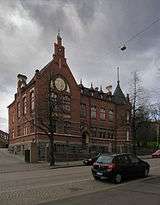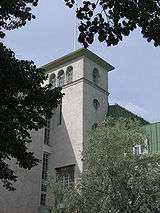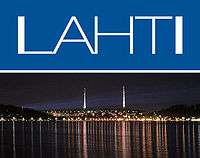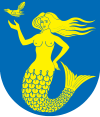Lahti
| Lahti Lahtis | ||
|---|---|---|
| City | ||
| Lahden kaupunki | ||
|
Skyline of Lahti and official logo | ||
| ||
| Nickname(s): Finland's Chicago, Business City | ||
 Location of Lahti in Finland | ||
| Coordinates: 60°59′N 025°39′E / 60.983°N 25.650°ECoordinates: 60°59′N 025°39′E / 60.983°N 25.650°E | ||
| Country | Finland | |
| Region | Päijänne Tavastia | |
| Sub-region | Lahti sub-region | |
| Charter | 1905-11-01 | |
| Government | ||
| • City manager | Jyrki Myllyvirta | |
| Area (2011-01-01)[1] | ||
| • Total | 154.58 km2 (59.68 sq mi) | |
| • Land | 135.05 km2 (52.14 sq mi) | |
| • Water | 19.53 km2 (7.54 sq mi) | |
| Area rank | 318th largest in Finland | |
| Population (2016-03-31)[2] | ||
| • Total | 118,885 | |
| • Rank | 8th largest in Finland | |
| • Density | 880.3/km2 (2,280/sq mi) | |
| Population by native language[3] | ||
| • Finnish | 95.7% (official) | |
| • Swedish | 0.3% | |
| • Others | 4% | |
| Population by age[4] | ||
| • 0 to 14 | 14.7% | |
| • 15 to 64 | 67.2% | |
| • 65 or older | 18.1% | |
| Time zone | EET (UTC+2) | |
| • Summer (DST) | EEST (UTC+3) | |
| Municipal tax rate[5] | 19.5% | |
| Website | www.lahti.fi | |
Lahti (Finnish pronunciation: [ˈlɑxti], Swedish: Lahtis) is a city and municipality in Finland.
Lahti is the capital of the Päijänne Tavastia region. It is situated on a bay at the southern end of lake Vesijärvi about 100 kilometres (60 mi) north-east of the capital Helsinki. In English, the Finnish word Lahti literally means bay. The Lahti region is growing and is one of the main economic hubs of Finland.
The coat of arms of the city depicts a train wheel surrounded by flames.
History
Lahti was first mentioned in documents in 1445. The village belonged to the parish of Hollola and was located at the medieval trade route of Ylinen Viipurintie, which linked the towns of Hämeenlinna and Vyborg.


The completion of the Riihimäki – St. Petersburg railway line in 1870 and the Vesijärvi canal in 1871 turned Lahti into a lively station, and industrial installations began to spring up around it. For a long time, the railway station at Vesijärvi Harbour was the second busiest station in Finland. Craftsmen, merchants, a few civil servants and a lot of industrial workers soon mixed in with the existing agricultural peasantry.
On 19 June 1877, almost the entire village was burned to the ground. However, the accident proved to be a stroke of luck for the development of the place, as it led to the authorities resuming their deliberations about establishing a town in Lahti. The village was granted market town rights in 1878 and an empire-style, grid town plan was approved, which included a large market square and wide boulevards. This grid plan still forms the basis of the city center. Most of the buildings were low wooden houses bordering the streets.
Lahti was founded during a period of severe economic recession. The Russian Empire was encumbered by the war against Turkey. The recession also slowed down the building of the township: land would not sell and often plots were not built on for some time. In its early years, the town with its meagre 200 inhabitants was too small to provide any kind of foundation for trade. At the end of the 1890s, Lahti’s Township Board increased its efforts to enable Lahti to be turned into a city. In spring 1904, the efforts finally bore fruit as the Senate approved of the application, although it was another eighteen months before Tsar Nicholas II finally gave his blessing and issued an ordinance for establishing the city of Lahti.
At the end of 1905, the area that now comprises Lahti accommodated around 8,200 people of whom just under 3,000 lived in the city itself. All essential municipal institutions were built in just ten years, including a hospital and a city hall. At the same time, a rapid increase in brick houses was taking place in the centre of the city.
In the early 1920s the city gained possession of the grounds of the Lahti Manor, an important piece of land previously blocking the city from the lake. Large-scale industrial operations grew rapidly in the 1930s as did the population; Lahti, at the time, was one of Finland’s fastest-growing cities, and before the start of the Winter War its population was approaching 30,000.
Through the addition of new areas in 1924, 1933 and 1956, Lahti grew, both in terms of population and surface area. Especially strong was the growth after the wars, when Lahti accepted about 10,000 immigrants from Karelia, after the region was surrendered to the Soviet Union, and then later in the 1960 and 70's as a result of mass urbanization. The population growth came to a sharp end in 1975 and the city has since grown very little, with the latest notable growth in population happening in 2016 when the municipality of Nastola became a part of Lahti.
Climate
| Climate data for Lahti, Finland | |||||||||||||
|---|---|---|---|---|---|---|---|---|---|---|---|---|---|
| Month | Jan | Feb | Mar | Apr | May | Jun | Jul | Aug | Sep | Oct | Nov | Dec | Year |
| Average high °C (°F) | −2.2 (28) |
−2.8 (27) |
1.1 (34) |
7.8 (46) |
16.1 (61) |
18.9 (66) |
22.2 (72) |
18.9 (66) |
12.8 (55) |
7.2 (45) |
1.1 (34) |
−1.1 (30) |
8.33 (47) |
| Daily mean °C (°F) | −6.7 (19.9) |
−7.2 (19) |
−2.8 (27) |
2.8 (37) |
10.0 (50) |
13.3 (55.9) |
16.7 (62.1) |
14.4 (57.9) |
8.9 (48) |
4.4 (39.9) |
−0.6 (30.9) |
−4.4 (24.1) |
4.07 (39.31) |
| Average low °C (°F) | −11.1 (12) |
−12.2 (10) |
−7.2 (19) |
−2.2 (28) |
3.9 (39) |
7.8 (46) |
11.1 (52) |
10.0 (50) |
5.0 (41) |
2.2 (36) |
−2.2 (28) |
−7.8 (18) |
−0.22 (31.6) |
| Average precipitation mm (inches) | 50 (1.97) |
30 (1.18) |
40 (1.57) |
30 (1.18) |
40 (1.57) |
60 (2.36) |
70 (2.76) |
80 (3.15) |
70 (2.76) |
60 (2.36) |
70 (2.76) |
50 (1.97) |
650 (25.59) |
| Average precipitation days | 10 | 8 | 9 | 11 | 12 | 12 | 13 | 13 | 14 | 17 | 14 | 11 | 144 |
| Source: Weatherbase.com [6] | |||||||||||||
Culture

Lahti harbors cultural ambitions, and recent years saw the building of a large congress and concert center, the Sibelius Hall. Lahti has one of Finland's most widely known symphony orchestras, the Lahti Symphony Orchestra (Sinfonia Lahti), which performs both classical and popular music, notably concentrating on music by Jean Sibelius.
Lahti’s annual music festival programme includes such events as Lahti Organ Festival, a jazz festival at the market square and Sibelius Festival.
Sports


Wintersports
Lahti has a rich sporting tradition, especially in various wintersports. The city is well known for the annually held Lahti Ski Games (Salpausselän kisat) and the Finlandia-hiihto cross-country skiing contest. It is also the only city to host the FIS Nordic World Ski Championships six times, doing so in 1926, 1938, 1958, 1978, 1989, and 2001, with the next championships to be held in 2017.
Ice hockey
The Pelicans have competed in the top level of Finnish ice hockey, the Liiga, since 1999. Before the new millennium Reipas represented Lahti in top-flight hockey for 50 years. Many former NHL players, such as Janne Laukkanen, Toni Lydman and Pasi Nurminen, have started their careers in Reipas.
Association football
Historically the city's most successful association football club has been Kuusysi. In their golden years lasting from the early 1980s to the 1990s they won five Finnish championships as well as two Finnish Cup titles, with appearances in European competitions each year. Their greatest rivals, Reipas, won a total of three championships and seven cup titles from 1963 to 1978 but diminished in the early 1980s as Kuusysi got stronger.
In the 1990s both clubs ended up in such massive financial difficulties that a merger was executed in 1996, with the newly formed club adopting a new name, crest and colours. FC Lahti has played in the Veikkausliiga since 1999, excluding a season-long visit to the first division in 2011, placing third and appearing in Europe twice.
Other events
The 1997 World Games and the 2009 World Masters Athletics Championships were held in Lahti. For the 1952 Summer Olympics, some of the football matches were played at Kisapuisto.
Education


Comprehensive and private education
Lahti has 16 comprehensive schools and eight secondary schools. Comprehensive education is also available in English and Swedish. Lahden yhteiskoulu is the city's only private school offering both comprehensive and upper secondary education.
Upper secondary and vocational education
All four upper secondary schools in Lahti have a specialty: the Lyceum has expertise on subjects such as mathematics and biology, Tiirismaa focuses on music in association with the Lahti Conservatory, Kannas organises theatre classes and students at Salpausselkä can enlist on a curriculum with additional emphasis on physical education.
Salpaus is an educational consortium owned by the municipalities in Päijänne Tavastia arranging most of the region's vocational education and trade schooling. The privately owned Dila and Lahti Conservatory educate students for healthcare and music-related professions, respectively.
Tertiary education
Lahti's greatest educational asset is the highly valued Institute of Design and Fine Arts, which is a part of Lahti University of Applied Sciences, the LAMK. The institute has gained international recognition in particular for jewelry and industrial design, while other areas of expertise include metal, woodworking and furniture.
There are two national sports institutes near Lahti. The Vierumäki International Sports Institute based in Heinola is the most versatile centre of sports and physical education in the country, operating under the Ministry of Culture and Education. In addition the Pajulahti Sports Institute, located in Nastola, is one of the leading sports and training centres in Finland.
One of Finland's six multidisciplinary university campuses is based in central Lahti. The University of Helsinki's Department of Environmental Sciences is the university's only science department located outside the Greater Helsinki area.

Economy
The economic region of Lahti, which includes the surrounding municipalities, was strongly affected by the collapse of Finnish-Soviet trade and by the recession in the early 1990s. The value of production slumped, especially in the mechanical engineering industry and other manufacturing industries (e.g. the furniture industry). Production also decreased in the textile and clothing industry. In 1990, there were 90,370 jobs in the Lahti region. The number of jobs diminished over the next couple of years, so that in 1993 there were fewer than 70,000 jobs in the region. The number of jobs had slowly increased to 79,138 in 1999.

| Employment by sector (City of Lahti) | 1980 | 1990 | 2000 | 2007 |
|---|---|---|---|---|
| Services | 52.0% | 59.3% | 63.5% | 72.4% |
| Industry | 47.1% | 40.1% | 36.4% | 27.4% |
| Agriculture & Forestry | 0.9% | 0.6% | 0.1% | 0.2% |
In 1995, R&D expenditure was FIM 715 per person, while Finland's average was about FIM 2050. The amount of Tekes (the National Technology Agency) funding in the Lahti Region grew 40% during 2004–07 while the average growth in Finland was 60%.

| Gross domestic product (Lahti Region) | 2000 | 2001 | 2002 | 2003 | 2004 | 2005 | 2006 |
|---|---|---|---|---|---|---|---|
| GDP at current prices; million € | 3,449.3 | 3,709.7 | 3,697.5 | 3,982.3 | 4,136.8 | 4,242.4 | 4,381.9 |
| Changes of GDP; year 2000 = 100% | 100.0% | 107.5% | 107.2% | 115.5% | 119.9% | 123.0% | 127.7% |
| GDP per capita; whole country =100% | 80.7% | 82.0% | 79.4% | 84.3% | 83.9% | 83.4% | 81.2% |
| GDP per employed; whole country =100% | 86.6% | 87.3% | 83.6% | 88.9% | 88.7% | 88.6% | 87.1% |
Demographics
As of 31 March 2016 the population of Lahti was 118,885, making it the eighth largest city in Finland by population. The population of Nastola, which became a part of Lahti on 1 January 2016, has not been noticed in the following chart.
| Population by district | 1964 | 1970 | 1980 | 1990 | 2000 | 2007 |
|---|---|---|---|---|---|---|
| Centre (Keskusta) | 27,400 | 21,800 | 15,600 | 13,700 | 17,280 | 19,778 |
| Laune | 13,200 | 17,100 | 23,300 | 22,600 | 23,670 | 24,568 |
| Kivimaa–Kiveriö–Joutjärvi | 17,100 | 23,500 | 20,700 | 18,300 | 17,790 | 16,974 |
| Kärpänen | 9,400 | 7,600 | 12,800 | 12,700 | 11,940 | 11,612 |
| Ahtiala | 4,600 | 5,100 | 5,100 | 9,100 | 10,500 | 10,897 |
| Mukkula | 1,300 | 9,100 | 9,500 | 8,500 | 8,120 | 7,877 |
| Jalkaranta | 2,500 | 1,950 | 5,600 | 6,200 | 6,020 | 5,852 |
| Kolava–Kujala | 900 | 550 | 400 | 300 | 310 | 710 |
Transportation
Local transport
The city is served by 20 local bus lines, most of which are pendulum lines between two different areas via city centre. Bus transport in the Päijänne Tavastia region is organised by the regional transportation authority, known as Lahden seudun liikenne or LSL, and run by several private companies which have bid for the right to run their lines. LSL buses cover all urban areas at 10-20 minute intervals and most nearby municipalities at 30-60 minute intervals.
Lahti is served by VR commuter rail, the Z train to Helsinki and the R train to Riihimäki run hourly. Most services to Kouvola don't have a letter designation and are run every three hours aside from rush hours. There are plans for building two new train stops inside the city limits before 2020, Hennala and Karisto. A local service to Heinola has been proposed but renovating the old line has been deemed too expensive and unprofitable in the long term, unless the Finnish state reaches an agreement with regional councils to finance a direct rail link from Lahti to either Jyväskylä or Mikkeli.
Long-distance transport

The city's main transportation hubs are the market square (Kauppatori) and the travel centre (Matkakeskus), with local buses providing a non-stop service between the two. The travel centre was built between 2014 and 2016 around the Lahti railway station by building new local bus stops around the station, a long-distance bus terminal next to the station building and an automated parking facility for commuters.
All local and long-distance trains and buses stop at the travel centre, making it convenient to transfer from one mode of transport to another. The city council has sold the old bus station in the city centre and it will be redeveloped for other uses in the near future.
Trivia
The asteroid 1498 Lahti was named after the city by its discoverer, the Finnish astronomer Yrjö Väisälä.
Notable people from Lahti
- Göran Enckelman, footballer
- Pasi Nurminen, former NHL goaltender
- Toni Lydman, former NHL player
- Toni Nieminen, ski jumper
- Janne Ahonen, ski jumper
- Mikko Ilonen, professional golfer
- Jari Litmanen, professional footballer
- Aksu Hanttu, drummer of Entwine
- Ilona Jokinen, soprano opera singer
- Jukka-Pekka Saraste, conductor and violinist
- Eija-Riitta Korhola, politician
- Jaana Pelkonen, politician and hostess of Eurovision Song Contest 2007
- Jimi Tenor, musician
- Timo Väänänen, musician, member of the band Loituma
- Mikko Aspa, musician, lone member of the band Clandestine Blaze
- Martina Valve, business woman
International relations
Twin towns—sister cities
Lahti is twinned with:
 Västerås, Sweden (since 1940)
Västerås, Sweden (since 1940) Akureyri, Iceland (since 1947)
Akureyri, Iceland (since 1947) Randers, Denmark (since 1947)
Randers, Denmark (since 1947) Ålesund, Norway (since 1947)
Ålesund, Norway (since 1947) Zaporizhzhya, Ukraine (since 1953)[7]
Zaporizhzhya, Ukraine (since 1953)[7] Pécs, Hungary (since 1956)
Pécs, Hungary (since 1956) Garmisch-Partenkirchen, Germany (since 1987)
Garmisch-Partenkirchen, Germany (since 1987) Suhl, Germany (since 1988)
Suhl, Germany (since 1988) Kaluga, Russia (since 1994)
Kaluga, Russia (since 1994) Narva, Estonia (since 1994, partnership agreement)
Narva, Estonia (since 1994, partnership agreement) Deyang, Sichuan, China (since 2000)
Deyang, Sichuan, China (since 2000) Most, Czech Republic
Most, Czech Republic
References
- ↑ "Area by municipality as of 1 January 2011" (PDF) (in Finnish and Swedish). Land Survey of Finland. Retrieved 9 March 2011.
- ↑ "Ennakkoväkiluku sukupuolen mukaan alueittain, maaliskuu.2016" (in Finnish). Statistics Finland. Retrieved 31 March 2016.
- ↑ "Population according to language and the number of foreigners and land area km2 by area as of 31 December 2008". Statistics Finland's PX-Web databases. Statistics Finland. Retrieved 29 March 2009.
- ↑ "Population according to age and gender by area as of 31 December 2008". Statistics Finland's PX-Web databases. Statistics Finland. Retrieved 28 April 2009.
- ↑ "List of municipal and parish tax rates in 2011". Tax Administration of Finland. 29 November 2010. Retrieved 13 March 2011.
- ↑ http://www.weatherbase.com/weather/weather.php3?s=592783
- ↑ Міста-побратими м. Запоріжжя [Twin Cities Zaporozhye]. City of Zaporizhia (in Ukrainian). Шановні відвідувачі і користувачі сайту. Archived from the original on 2012-08-03. Retrieved 2013-08-07.
External links
| Wikimedia Commons has media related to Lahti. |
- 1952 Summer Olympics official report. pp. 62–3.
- City of Lahti – Official city website.
- Lahti Guide – information for visitors to Lahti.
- Lahti region - Living, business and travel information.
- Lahti info - News, events, business and other information.
- Lahti video - documentary about city of Lahti
 Lahti travel guide from Wikivoyage
Lahti travel guide from Wikivoyage
Maps
Media
- Etelä-Suomen Sanomat – local newspaper in Finnish (translates as South Finland News)



